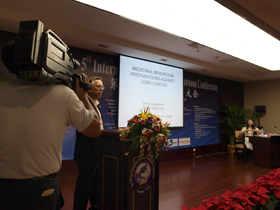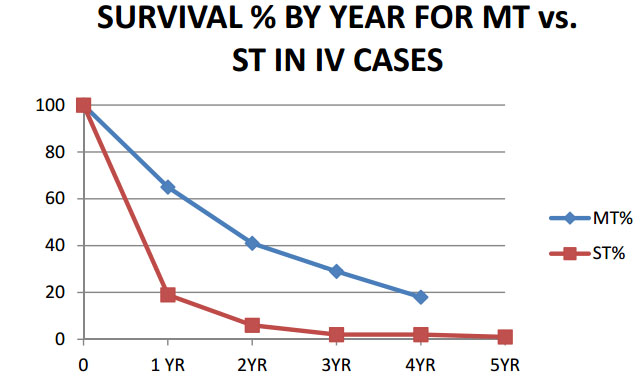Effects of medicinal mushroom extracts in patients with lung cancer

In this cohort study of 65 patients with lung cancer (13 small-cell cancer and 52 non-small-cell lung cancer cases), intensive doses of Dr Myko San products Lentifom, Super Polyporin and Agarikon were taken intensively (average of 60–100 days), in the period from early 2004 to mid-2007, parallel with or following chemotherapy. The analysis is based on the official medical records from hospitals where patients received standard oncological treatment, and information received from patients and their family members.
This study was presented at the 5th International Conference on Medicinal Mushrooms, Nantong, China 2009.
Patients with small-cell lung cancer (N=13)
At the start of mycotherapy, 9 patients were in the limited stage and 4 in the advanced stage of the disease.
At the end of intensive mycotherapy, 3 patients experienced complete regression, 4 had partial regression, while in one patient there was further advancement (tumour growth). The performance status remained unchanged in 4 patients and improved in 3 patients. In terms of tolerating chemotherapy, 2 patients reported having no side effects at all, while 5 reported reduced side effects of chemotherapy.
Due to a lack of data from the Croatian National Cancer Registry, and due to the gaps in the available medical records, we compared the median patient survival with the American data (Skeel, Handbook of Cancer Chemotherapy, Lippincott), calculating the median survival from the start of use of intensive mycotherapy, and not from the time of first diagnosis as listed in the American data. It should also be noted that at the time, the survival rate in the US was substantially higher than in Europe.
Even this less precise comparison showed that in comparison to the median 14-month survival rate in American patients in the limited stage of small-cell lung cancer, patients taking intensive doses of these Dr Myko San mushroom extracts had a median survival period of 37 months. The median survival of patients with extended small-cell lung carcinoma in the American data was just 7–9 months, as opposed to 27 months among patients on intensive mycotherapy. It is important to stress that the US data on median survival are calculated from the time of first diagnosis, while for patients on mycotherapy, this was calculated from the start of intensive use of medicinal mushroom extracts (most often 6–12 months after first diagnosis).
At the end of the study period (June 2009), 4 patients were alive, with a median survival period of 42 months. In May 2015, 2 of those patients were still alive and living without any signs of the disease (more than 9 years after diagnosis).
In general, it can be concluded that the patients taking the Dr Myko San medicinal mushroom extracts in addition to the regular oncology treatment lived longer and had a better survival rate.
Patients with non-small-cell lung cancer (N=52)
The sample of patients with non-small-cell lung carcinoma included 52 patients, of which 24 had adenocarcinoma, 3 large-cell carcinoma, 13 squamous cell carcinoma and 12 with non-specific non-small-cell lung cancer. Only 7 patients underwent surgery, while the remaining 45 had inoperable lung cancer (6 recurring). The sample was primarily made of those in very advanced stages of the disease: 10 in stage 3A and 20 in stage 4 (with remote metastases).
At the end of intensive mycotherapy, 15 patients had partial regression, 10 showed no changes, while 3 patients had progressions (measured as tumour size). The performance status (overall condition) remained unchanged in 12 patients, improved for 10 patients, and was worsened in 4 cases. Two patients reported undergoing chemotherapy without any side effects, 9 with mild side effects, and 5 did not notice any differences in how they tolerated chemotherapy.
At the end of the 5-year study (June 2009), 8 patients were alive, of which 4 were without any signs of the disease.
In general, it can be concluded that the patients taking Dr Myko San medicinal mushroom extracts in addition to the regular oncology treatment lived longer and had a better survival rate. As for non-small-cell lung cancer, we used the US patient survival rate (National Cancer Institute) for comparison. It is important to stress that the US data on median survival are calculated from the time of first diagnosis, while for patients on mycotherapy, this was calculated from the start of intensive use of medicinal mushroom extract (most often 6 – 12 months after first diagnosis).
An extension of life was seen at the level of the overall patient sample with this form of lung cancer when using intensive mycotherapy i.e. mushroom extracts. For example, among patients in the most advanced stage of the disease (stage 4 with remote metastases), the 4-year survival rate among those taking intensive mycotherapy was 18%, as compared to just 2% of American patients receiving standard oncological treatment.

Patients using the said Dr Myko San medicinal mushroom extracts also reported better tolerance to chemotherapy and/or radiation therapy, with reduced side effects.
The clear dose-dependence effect of intensive mycotherapy on survival rate and improved performance status of patients with non-small-cell lung cancer should be noted. For example, two years after intensive mycotherapy in the group taking medicinal mushrooms extracts for 70 – 100 days, survival was 40%, while in the group taking the extracts intensively for 110 or more days, survival was 60%.
After intensive mycotherapy, patients who continued the occasional use of the medicinal mushroom extracts lived longer and had a higher survival rate, both with small-cell and non-small-cell lung cancer.
For more details, please see the presentation.
